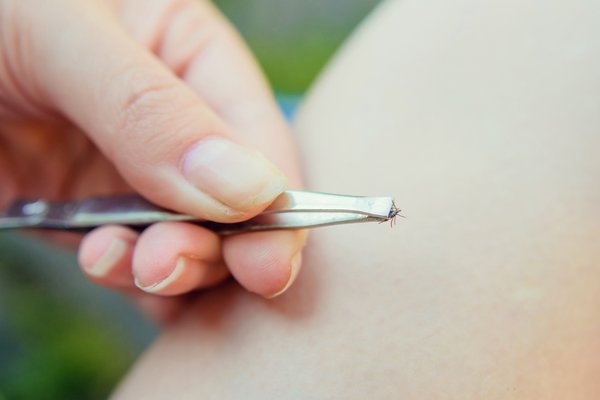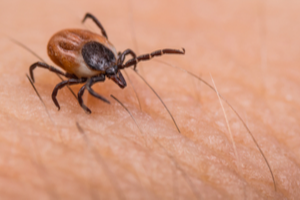Ticks can latch on anywhere, but they’re fond of warm, dark places such as armpits, joints, behind ears or in hair. They will typically try to crawl to your head. After returning from a tick hunting ground, strip and use a mirror to check for tick bites thoroughly.
Ticks can be surprisingly difficult to find, even when they’re attached to your body. Tick bites are painless because the bloodsuckers’ saliva contains a localized anesthetic, so you won’t feel them bite down. After catching a ride on your body, they also like to climb to warm, dark places around your body, which may make them even more difficult to find. In order to effectively find ticks, you have to know when to look, where to look, and what to look for. We can help you learn each of those things:
When to look for tick bites
Michigan’s ticks live in tall grasses, shrubs, brush, and forested areas. They hunt, or “quest,” by climbing to perches on vegetation near footpaths and waiting for prey to wander by. If you get close enough, they’ll simply grab on as you walk by. Tick’s legs are hooked to make clinging to and moving on clothing and fur easier. The longer you spend around their possible perches, the more likely it is that ticks will crawl onto you.
It’s important to check for ticks whenever you spend an extended period of time near their habitats outside. Obviously, this means after camping trips, hikes, walks through woods or grassy fields, or trips to the park. Unfortunately, however, some ticks may live closer to home than we’d like to admit. You should also check for ticks after yard work or gardening, especially in summer time. Any time you’re outside and around vegetation, you could be around ticks.
Where to look for tick bites
Ticks can bite down on any part of your body, but they have a few different favorite spots. First, they seek out areas where they can consume a lot of blood quickly. They’ll look for centers of circulation and heat. For this reason, ticks are most attracted to your head and will make their way up your body to reach it if they can. Consequently, ticks frequently attach themselves higher on your body than you may expect.
Ticks also prefer to attach to areas with thin skin, where they can access blood more easily. They’ll look for areas like your scalp, ankles, hips, knees, and elbows. Finally, ticks tend to like warm, moist, hidden areas where they won’t be bothered. They’ll frequently crawl near armpits, joints such as the back of your knees, your hair, or the underside of your breasts. Remember, though: even if you don’t find ticks in the likely spots, you should still check everywhere else, too.
What to look for to identify tick bites
Counter-intuitive as it may seem, you want the tick that has bitten you to have remained attached. This makes their bite much easier to find and means they haven’t been attached for too long. Remember that ticks are very small, so you may not immediately recognize them as ticks even if you’re looking right at them. Furthermore, ticks can burrow their bodies further into skin until they become partially buried under the skin.
Basically, when ticks are on your body they may only look like small brown or black spots. The area on or around the bite may turn red, develop a rash, become inflamed, or swell. Unlike mosquito bites, it will not contain liquid, though it may itch. Ticks could stay attached to people for anywhere between 3 and 10 days, depending on several factors. If you’re unsure if you’re looking at a tick bite, try a magnifying glass or feel for a bump.
To summarize: check for ticks after you spend an extended period of time outside and/or in grassy, overgrown, or forested areas. Check all over your body, but pay special attention to your hair and scalp, ears, neck, shoulder blades, armpits, elbows, hips, knees, and ankles. Look for small black and brown spots, bumps, rashes, protrusions, and swelling.
If you seem to be having a lot of tick problems this summer, remember that you don’t have to suffer in silence. Just because ticks can live near your home doesn’t mean they should. If you need help getting ticks away from you, give Griffin Pest Solutions a call any time. We can drive off the bloodsuckers for good.









